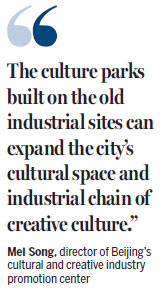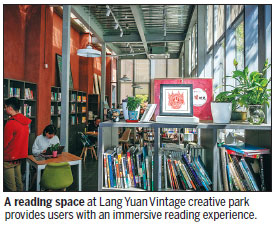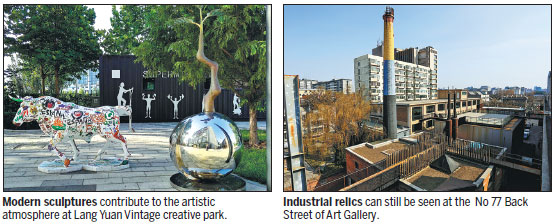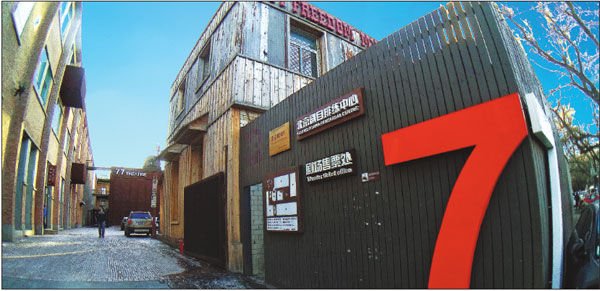OLD FACTORIES BRINGING NEW VITALITY TO BEIJING
Unused spaces across China's capital being repurposed for artistic development, Li You reports.
Beijing's effort to revitalize its old industrial sites has led to the creation of some 6 million square meters of art communities, creative cultural parks and working spaces scattered across the city.
The ongoing reconstruction is the result of a framework developed by city leaders, who called for the protection and utilization of old factories to expand space for cultural development and creative industries, as well as public facilities.

The framework, issued by the Beijing municipal government in April, established clear principles for the redevelopment, as well as the necessary policies and measures to make that development happen.
Beijing, the capital city of China, has limited land resources. But city leaders have found a solution by focusing on the reuse of old factories, which occupy a considerable amount of land.
At present, a total of about 25 million sq m of old factory sites has been cleared out of the city, in addition to the 6 million sq m of land where redevelopment work has been finished, and an additional 1.38 million sq m that are undergoing the transformation process, according to Beijing's cultural and creative industry promotion center.
Xidian village in Beijing's Chaoyang district, for example, used to be the location of a forgotten factory site. Six crossroads train routes coincide at the place, cutting the area into several separated parts.
Today, the structure of the old factories in Xidian still stands, but their appearance has been totally transformed into a unique cultural industrial park that has attracted hundreds of business startups in the creative cultural industry.
"The rhythm of the train is very similar to that of the movies, which can bring me a lot of inspiration," said Xing Peng, director of the park. "And the railway, the roads and the bridges - all of the industrial elements - embody the concept of the creative cultural zone and make it a uniform world."
Industrial relics with decades of history such as those in Xidian can be found across Beijing. Old factory buildings with long histories can be found mainly in Chaoyang, Haidian, Fengtai and Shijingshan districts; the ones with relatively short histories are mainly in Shunyi, Changping and Daxing districts, as well as the Beijing Etown Economic-technological Development Area.
In recent years, more and more industrial remains have been transformed into creative industrial parks, such as the Lang Yuan Vintage creative park in Chaoyang district, Beijing 798 Art District, the No 77 Back Street of Art Gallery and the Shougang Industrial Park.
The 798 Art District lies in the 718 factory of Beijing Sevenstar Science and Technology. The total construction area of 230,000 sq m includes many cultural elements such as galleries, design studios, art exhibition spaces, artists' studios, fashion shops and restaurants. In the past 10 years, artists and art enterprises have been flocking to the site.
Nowadays, the area has become the capital of Beijing's fashion culture and was listed as a cultural tourist attraction for the 2008 Beijing Olympics.
The project of Lang Yuan Vintage to develop cultural industry started from 2014. At present, the district has attracted more than 50 enterprises, providing more than 4,000 jobs, mostly in creative culture, creative, information technology and art design.
Recently, an abandoned bicycle shed built in the 1980s on Tiancun Road has been rebuilt into a cultural courtyard. It consists of a reading hall, a national study museum, a chess museum, a rehabilitation hall, a children's hall and an exhibition hall.
To the neighbors, the cultural courtyard has become a place to read and study, enjoy recreation and leisure and chat with friends and neighbors, all of which has greatly enriched their daily life.
Amid the campaign to phase out non-capital functions from the capital, more than 200 manufacturing companies will move out in the next three years.
"The culture parks built on the old industrial sites can expand the city's cultural space and industrial chain of creative culture," said Mei Song, director of Beijing's cultural and creative industry promotion center.
According to Fan Zhou, a professor from Communication University of China, the development of culture parks can reinvigorate the land resources of old factories and enhance the cultural atmosphere of the city, achieving multiple purposes at one stroke to propel the city's development.
Contact the writer at liyou@chinadaily.com.cn
|
A theater has been built on the site of the No 77 Back Street of Art Gallery, a place that used to be an industrial site.Photos Provided To China Daily |


(China Daily 07/24/2018 page7)















